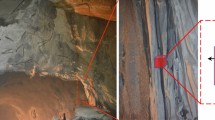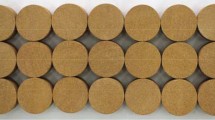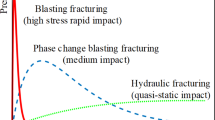Abstract
The geo-mechanical properties of reservoirs, especially the morphology of the rock surface and the fracture properties of rocks, are of great importance in the modeling and simulation of hydraulic processes. To better understand these fundamental issues, five groups of mixed-mode fracture tests were conducted on sandstone using edge-cracked semi-circular bend specimens. Accordingly, the fracture loads, growth paths and fracture surfaces for different initial mixities of the mixed-mode loadings from pure mode I to pure mode II were then determined. A surface topography measurement for each rough fracture surface was conducted using a laser profilometer, and the fractal properties of these surfaces were then investigated. The fracture path evolution mechanism was also investigated via optical microscopy. Moreover, the mixed-mode fracture strength envelope and the crack propagation trajectories of sandstone were theoretically modeled using three widely accepted fracture criteria (i.e., the MTS, MSED and MERR criterions). The published test results in Hasanpour and Choupani (World Acad Sci Eng Tech 41:764–769, 2008) for limestone were also theoretically investigated to further examine the effectiveness of the above fracture criteria. However, none of these criteria could accurately predict the fracture envelopes of both sandstone and limestone. To better estimate the fracture strength of mixed-mode fractures, an empirical maximum tensile stress (EMTS) criterion was proposed and found to achieve good agreement with the test results. Finally, a uniformly pressurized fracture model was simulated for low pressurization rates using this criterion.













Similar content being viewed by others
Abbreviations
- a :
-
Crack length
- B :
-
Thickness of an SCB specimen
- d :
-
Half-distance of two bottom supports of an SCB specimen
- E :
-
Young’s modulus
- f :
-
Coefficient of friction
- F :
-
Applied load in an SCB 3PB test
- F max :
-
Peak load in an SCB 3PB test
- G :
-
Energy release rate
- G c :
-
Critical energy release rate
- K I :
-
Mode I stress intensity factor
- K II :
-
Mode II stress intensity factor
- K Ic :
-
Mode I fracture toughness
- K IIc :
-
Mode II fracture toughness
- k 1 :
-
=K I/K Ic
- k 2 :
-
=K II/K IIc
- M :
-
Mixity of a given mixed-mode loading
- M 0 :
-
Initial loading mode mixity
- p :
-
Pressure acting on the wellbore and the fracture surfaces
- p i :
-
Pressure acting on the wellbore and the fracture surfaces for sub-step i
- R :
-
Radius of an SCB specimen
- r, θ :
-
Polar co-ordinates at the crack tip
- r c :
-
Critical radius of the core region in the crack initiation direction
- r Ic :
-
Critical radius of the core region in the initiation direction of a mode I crack
- r IIc :
-
Radius of the core region in the initiation direction of a mode II crack
- R w :
-
Radius of a wellbore
- S :
-
Strain energy density factor
- S c :
-
Critical strain energy density factor
- T :
-
Nonsingular term stress
- Y I :
-
Non-dimensional mode I stress intensity factor
- Y II :
-
Non-dimensional mode II stress intensity factor
- α I, α II :
-
Magnitude parameters of a mixed-mode loading
- β :
-
Crack inclined angle for an SCB specimen
- θ 0 :
-
Crack initiation angle
- κ :
-
=3 − 4ν for plain strain, =(3 − ν)/(1+ν) for plain stress
- λ :
-
An empirical coefficient calculated from (r c/r Ic)1/2
- μ :
-
Modulus of rigidity
- ν :
-
Poisson’s ratio
- σ h :
-
Far-field in-plane minimum principal stress
- σ H :
-
Far-field in-plane maximum principal stress
- σ n :
-
Normal stress acting on the fracture surfaces
- σ θθ :
-
Tangential stress ahead of a crack
- σ θθc :
-
Critical tangential stress
- φ :
-
Normalized dimensionless parameter that controls the fracture path
References
Adachi J, Siebrits E, Peirce A, Desroches J (2007) Computer simulation of hydraulic fractures. Int J Rock Mech Min Sci 44:739–757. doi:10.1016/j.ijrmms.2006.11.006
Aghighi MA, Rahman SS (2010) Initiation of a secondary hydraulic fracture and its interaction with the primary fracture. Int J Rock Mech Min Sci 47:714–722
Ai T, Zhang R, Zhou HW, Pei JL (2014) Box-counting methods to directly estimate the fractal dimension of a rock surface. Appl Surf Sci 314:610–621
Akbardoost J, Ayatollahi MR (2014) Experimental analysis of mixed mode crack propagation in brittle rocks: the effect of non-singular terms. Eng Fract Mech 129:77–89
Aliha MRM, Ayatollahi MR (2011) Mixed mode I/II brittle fracture evaluation of marble using SCB specimen. Proc Eng 10:311–318. doi:10.1016/j.proeng.2011.04.054
Aliha MRM, Ayatollahi MR, Smith DJ, Pavier MJ (2010) Geometry and size effects on fracture trajectory in a limestone rock under mixed mode loading. Eng Fract Mech 77:2200–2212. doi:10.1016/j.engfracmech.2010.03.009
Aliha MRM, Hosseinpour GR, Ayatollahi MR (2013) Application of cracked triangular specimen subjected to three-point bending for investigating fracture behavior of rock materials. Rock Mech Rock Eng 46:1023–1034
Al-Shayea NA (2005) Crack propagation trajectories for rocks under mixed mode I–II fracture. Eng Geol 81:84–97. doi:10.1016/j.enggeo.2005.07.013
Antunes FV, Ramalho A, Ferreira JM (2000) Identification of fatigue crack propagation modes by means of roughness measurements. Int J Fatigue 22:781–788
Ayatollahi MR, Aliha MRM (2007) Wide range data for crack tip parameters in two disc-type specimens under mixed mode loading. Comp Mater Sci 38:660–670. doi:10.1016/j.commatsci.2006.04.008
Ayatollahi MR, Saboori B (2015) Maximum tangential strain energy density criterion for general mixed mode I/II/III brittle fracture. Int J Damage Mech 24:263–278. doi:10.1177/1056789514530745
Ayatollahi MR, Aliha MRM, Hassani MM (2006) Mixed mode brittle fracture in PMMA—an experimental study using SCB specimens. Mater Sci Eng A 417:348–356. doi:10.1016/j.msea.2005.11.002
Babadagli T, Develi K (2003) Fractal characteristics of rocks fractured under tension. Theor Appl Fract Mech 39:73–88
Backers T, Stephansson O (2012) ISRM suggested method for the determination of mode II fracture toughness. Rock Mech Rock Eng 45:1011–1022
Berchenko I, Detournay E, Chandler N (1997) Propagation of natural hydraulic fractures. Int J Rock Mech Min Sci 34:63-e61
Bunger AP, Gordeliy E, Detournay E (2013) Comparison between laboratory experiments and coupled simulations of saucer-shaped hydraulic fractures in homogeneous brittle-elastic solids. J Mech Phys Solids 61:1636–1654
Byerlee J (1978) Friction of rocks. Pure Appl Geophys 116:615–626
Chang S-H, Lee C-I, Jeon S (2002) Measurement of rock fracture toughness under modes I and II and mixed-mode conditions by using disc-type specimens. Eng Geol 66:79–97. doi:10.1016/S0013-7952(02)00033-9
Chong KP, Kuruppu MD (1984) New specimen for fracture toughness determination for rock and other materials. Int J Fract 26:R59–R62. doi:10.1007/BF01157555
Economides MJ, Martin T, BJ Services Company (2007) Modern fracturing: enhancing natural gas production. Energy Tribune Publishing, Houston
Erdogan F, Sih GC (1963) On the crack extension in plates under plane loading and transverse shear. J Basic Eng 85:519–527
Funatsu T, Shimada H, Matsui K, Seto M (2014a) Effect of temperature and confining pressure on mixed-mode (I–II) and mode II fracture toughness of Kimachi sandstone. Int J Rock Mech Min Sci 67:1–8
Funatsu T, Shimizu N, Kuruppu M, Matsui K (2014b) Evaluation of mode I fracture toughness assisted by the numerical determination of K-resistance. Rock Mech Rock Eng 48:143–157
Garagash DI (2006) Propagation of a plane-strain hydraulic fracture with a fluid lag: early-time solution. Int J Solids Struct 43:5811–5835
Glover PWJ, Matsuki K, Hikima R, Hayashi K (1997) Fluid flow in fractally rough synthetic fractures. Geophys Res Lett 24:1803–1806
Hahn GT (1984) The influence of microstructure on brittle fracture toughness. Metall Trans A 15:947–959. doi:10.1007/BF02644685
Hasanpour R, Choupani N (2008) Mixed-mode study of rock fracture mechanics by using the modified Arcan specimen test. World Acad Sci Eng Tech 41:764–769
Hatzor YH, Palchik V (1997) The influence of grain size and porosity on crack initiation stress and critical flaw length in dolomites. Int J Rock Mech Min Sci 34:805–816
Hossain MM, Rahman MK (2008) Numerical simulation of complex fracture growth during tight reservoir stimulation by hydraulic fracturing. J Pet Sci Eng 60:86–104
Hussain MA, Pu SL, Underwood J (1974) Strain energy release rate for a crack under combined mode I and mode II. Fract Anal ASTM STP 560:2–28
Im S, Ban H, Kim Y-R (2014) Characterization of mode-I and mode-II fracture properties of fine aggregate matrix using a semicircular specimen geometry. Constr Build Mater 52:413–421
Isakov E, Ogilvie SR, Taylor CW, Glover PWJ (2001) Fluid flow through rough fractures in rocks I: high resolution aperture determinations. Earth Planet Sci Lett 191:267–282
Khan K, Al-Shayea NA (2000) Effect of specimen geometry and testing method on mixed mode I–II fracture toughness of a limestone rock from Saudi Arabia. Rock Mech Rock Eng 33:179–206
Khan SMA, Khraisheh MK (2004) A new criterion for mixed mode fracture initiation based on the crack tip plastic core region. Int J Plast 20:55–84. doi:10.1016/s0749-6419(03)00011-1
Klein E, Reuschlé T (2004) A pore crack model for the mechanical behaviour of porous granular rocks in the brittle deformation regime. Int J Rock Mech Min Sci 41:975–986. doi:10.1016/j.ijrmms.2004.03.003
Krishnan GR, Zhao XL, Zaman M, Roegiers JC (1998) Fracture toughness of a soft sandstone. Int J Rock Mech Min Sci 35:695–710. doi:10.1016/S0148-9062(97)00324-0
Kuruppu MD, Chong KP (2012) Fracture toughness testing of brittle materials using semi-circular bend (SCB) specimen. Eng Fract Mech 91:133–150. doi:10.1016/j.engfracmech.2012.01.013
Kuruppu MD, Obara Y, Ayatollahi MR, Chong KP, Funatsu T (2014) ISRM-suggested method for determining the mode I static fracture toughness using semi-circular bend specimen. Rock Mech Rock Eng 47:267–274. doi:10.1007/s00603-013-0422-7
Kusumoto S, Gudmundsson A, Simmenes TH, Geshi N, Philipp SL (2013) Inverse modeling for estimating fluid-overpressure distributions and stress intensity factors from an arbitrary open-fracture geometry. J Struct Geol 46:92–98
Lee HS, Cho TF (2002) Hydraulic characteristics of rough fractures in linear flow under normal and shear load. Rock Mech Rock Eng 35:299–318. doi:10.1007/s00603-002-0028-y
Lim IL, Johnston IW, Choi SK (1993) Stress intensity factors for semi-circular specimens under three-point bending. Eng Fract Mech 44:363–382
Lim IL, Johnston IW, Choi SK, Boland JN (1994) Fracture testing of a soft rock with semi-circular specimens under three-point bending. Part 2—mixed-mode. Int J Rock Mech Min Sci Geomech Abs 31:199–212. doi:10.1016/0148-9062(94)90464-2
Mandelbrot BB (1983) The fractal geometry of nature. Henry Holt and Company, New York
Méheust Y, Schmittbuhl J (2000) Flow enhancement of a rough fracture. Geophys Res Lett 27:2989–2992
Mirsayar M (2014) A new mixed mode fracture test specimen covering positive and negative values of T-stress. Eng Solid Mech 2:67–72
Mishuris G, Wrobel M, Linkov A (2012) On modeling hydraulic fracture in proper variables: stiffness, accuracy, sensitivity. Int J Eng Sci 61:10–23
Mogilevskaya SG, Rothenburg L, Dusseault MB (2000) Growth of pressure-induced fractures in the vicinity of a wellbore. Int J Fract 104:23–30
Palaniswamy K, Knauss WG (1972) Propagation of a crack under general, in-plane tension. Int J Fract Mech 8:114–117. doi:10.1007/BF00185207
Rahman MK, Joarder AH (2006) Investigating production-induced stress change at fracture tips: implications for a novel hydraulic fracturing technique. J Pet Sci Eng 51:185–196
Rao Q, Sun Z, Stephansson O, Li C, Stillborg B (2003) Shear fracture (mode II) of brittle rock. Int J Rock Mech Min Sci 40:355–375
Ren L, Zhu Z, Wang M, Zheng T, Ai T (2013a) Mixed-mode elastic-plastic fractures: improved R-criterion. J Eng Mech 140:04014033
Ren L, Zhu Z, Yang Q, Ai T (2013b) Investigation on the applicability of several fracture criteria to the mixed mode brittle fractures. Adv Mech Eng 5:545108. doi:10.1155/2013/545108
Richard HA, Schramm B, Schirmeisen NH (2014) Cracks on mixed mode loading-theories, experiments, simulations. Int J Fatigue 62:93–103. doi:10.1016/j.ijfatigue.2013.06.019
Sarmadivaleh M, Rasouli V (2015) Test design and sample preparation procedure for experimental investigation of hydraulic fracturing interaction modes. Rock Mech Rock Eng 48:93–105
Sih GC (1974) Strain-energy-density factor applied to mixed mode crack problems. Int J Fract 10:305–321. doi:10.1007/BF00035493
Swartz SE, Taha NM (1990) Mixed mode crack propagation and fracture in concrete. Eng Fract Mech 35:137–144
Tokunaga TK, Wan J, Sutton SR (2000) Transient film flow on rough fracture surfaces. Water Res Res 36:1737–1746
Wei H, Li L, Wu X, Hu Y (2011) The analysis and theory research on the factor of multiple fractures during hydraulic fracturing of CBM wells. Proc Earth Planet Sci 3:231–237
Whitcomb JD (1986) Parametric analytical study of instability-related delamination growth. Comp Sci Technol 25:19–48
Xeidakis GS, Samaras IS, Zacharopoulos DA, Papakaliatakis GE (1997) Trajectories of unstably growing cracks in mixed mode I–II loading of marble beams. Rock Mech Rock Eng 30:19–33
Yeo IW, de Freitas MH, Zimmerman RW (1998) Effect of shear displacement on the aperture and permeability of a rock fracture. Int J Rock Mech Min Sci 35:1051–1070. doi:10.1016/S0148-9062(98)00165-X
Zhang X, Jeffrey RG (2006) The role of friction and secondary flaws on deflection and re-initiation of hydraulic fractures at orthogonal pre-existing fractures. Geophys J Int 166:1454–1465. doi:10.1111/j.1365-246X.2006.03062.x
Zhang Z, Nemcik J (2013) Friction factor of water flow through rough rock fractures. Rock Mech Rock Eng 46:1125–1134
Zhang QB, Zhao J (2013) Effect of loading rate on fracture toughness and failure micromechanisms in marble. Eng Fract Mech 102:288–309. doi:10.1016/j.engfracmech.2013.02.009
Zhang X, Jeffrey RG, Thiercelin M (2009) Mechanics of fluid-driven fracture growth in naturally fractured reservoirs with simple network geometries. J Geophys Res Solid Earth 114:B12406. doi:10.1029/2009JB006548
Zhang X, Jeffrey RG, Bunger AP, Thiercelin M (2011) Initiation and growth of a hydraulic fracture from a circular wellbore. Int J Rock Mech Min Sci 48:984–995
Zhang R, Ai T, Zhou HW, Ju Y, Zhang ZT (2015) Fractal and volume characteristics of 3D mining-induced fractures under typical mining layouts. Environ Earth Sci 73:6069–6080
Zhao H, Chen M (2010) Extending behavior of hydraulic fracture when reaching formation interface. J Petrol Sci Eng 74:26–30
Zhou HW, Xie H (2003) Direct estimation of the fractal dimensions of a fracture surface of rock. Surf Rev Lett 10:751–762. doi:10.1142/S0218625X03005591
Acknowledgments
The authors would like to thank Prof. Qizhi Wang of Sichuan University for his kind help. This work was financially supported by the Provincial Science and Technology Support Project of Sichuan Province (2012FZ0124) and the Major State Basic Research Project of NSFC (2011CB201201).
Author information
Authors and Affiliations
Corresponding author
Rights and permissions
About this article
Cite this article
Ren, L., Xie, L.Z., Xie, H.P. et al. Mixed-Mode Fracture Behavior and Related Surface Topography Feature of a Typical Sandstone. Rock Mech Rock Eng 49, 3137–3153 (2016). https://doi.org/10.1007/s00603-016-0959-3
Received:
Accepted:
Published:
Issue Date:
DOI: https://doi.org/10.1007/s00603-016-0959-3




